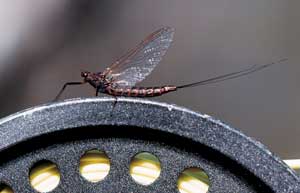
Each March, sports junkies across the country turn their attention to a certain college basketball tournament.
This event temporarily grips the nation’s sports psyche and whips fans of the participating teams into a month-long frenzy. During that same time, trout anglers who use fly rods experience their own brand of March Madness — the advent of the year’s first substantial mayfly hatches.
Trying to predict the precise dates of these hatches is an exercise in futility.
Times may vary from year to year, river system to river system, and even at different stretches of the same river. As a rule, however, the colder the weather, the later the hatch will occur.
The insect most associated with the sport of fly fishing is the mayfly. Adult mayflies are slender and graceful with upright wings and elongated abdomens and tails.
The adult and nymph of the species are important food sources for trout and an essential imitation for the fly fisherman to carry at all times.
mayflies have two adult stages. When they first emerge from the water, they are called duns (scientifically known as the subimago stage). Shortly thereafter, they molt into the spinner (imago) stage, mate and die. An adult mayfly will live only a day or two after emerging from the water.
There approximately 2500 species of mayflies throughout the world. In South Carolina and the mountain region of the southeast, there are several hundred.
Here are my Final Four picks for the most important mayfly hatches to look for early this spring.
1) Blue-winged Olive. This is likely to be the first mayfly encountered in any new year.
There are dozens of mayfly species given the Blue-winged Olive moniker, but all of the adult insects have smoky-blue wings, tails and legs with an olive-green body.
Blue-winged Olives are notorious bad-weather insects, so look for decent hatches on the river during low-pressure days with light rain.
The species that are classified as Blue-winged olives by anglers can range in sizes from 14 to 28. Light, sporadic hatches can occur throughout the winter, but they really come on in early spring.
There are dozens of patterns that imitate various Blue-winged Olives mayflies, but an Adams in the appropriate size often will work as well as any specialized BWO fly pattern.
2) Blue Quill. Blue Quill mayflies start hatching in late February to mid March at our area.
Their bodies, wings, and tails are blue or grey in color and are most common in sizes 16 and 18.
When the air temperature is low, Blue Quill duns ride the surface of the water for a long time, unable to fly. This, obviously, makes them a slam dunk for feeding trout and a bonanza for the angler as well.
Blue Quill dry flies and the Adams will catch fish when these insects are on the water.
3) March Brown. The March Brown mayfly is the largest mayfly one is likely to encounter at a South Carolina trout stream.
Its body is dark brown and tan while its large wings are light brown with mottled markings. The newly-hatched dun is a meaty morsel, about a size 10, and even large trout will come up to eat this fly on the surface.
Sections of the Chattooga River have good hatches of March Browns in late March and April and makes for some exciting dry fly fishing.
Fishing nymphs can provide good action from mid-morning into the early stages of the hatch.
A Gold Ribbed Hares Ear and Olive Hares Ears are valuable flies to have during this time and sometimes will out-fish the dun imitations on the surface.
4) Quill Gordon. This is usually the first mayfly of any significant size to emerge on many streams of South Carolina.
They are named for the remarkably effective and historically famous fly pattern that imitates them. They vary tremendously in color, from blue to brown to dark amber — in sizes 12 to 14.
The appearance of Quill Gordons is a most welcome sight as they appear during the warmest part of the day and usually herald the beginning of the season’s dry-fly action.
This bug differs from most mayflies in that instead of swimming to the surface to emerge, it escapes its nymphal shuck on the stream-bottom and the fly, fully formed, swims to the surface.
This is truly the time of year when fly anglers get pumped up.
To trout anglers, nothing’s a better harbinger of spring and great fishing than mayfly hatches.



Be the first to comment